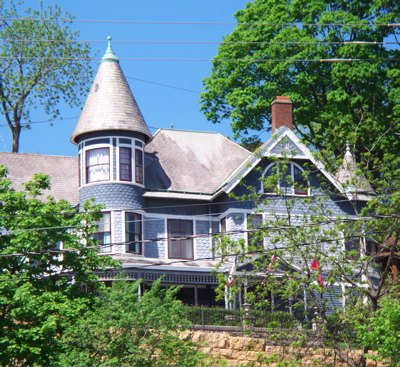Encyclopedia Dubuque
"Encyclopedia Dubuque is the online authority for all things Dubuque, written by the people who know the city best.”
Marshall Cohen—researcher and producer, CNN
Affiliated with the Local History Network of the State Historical Society of Iowa, and the Iowa Museum Association.
WITCH'S CAP: Difference between revisions
No edit summary |
No edit summary |
||
| Line 1: | Line 1: | ||
[[Image:witch's cap.jpg|left|thumb|450px|]]WITCH'S CAP. The upside down cone-shaped decoration on this house helps identify it as an example of [[QUEEN ANNE ARCHITECTURE]]. | [[Image:witch's cap.jpg|left|thumb|450px|]]WITCH'S CAP. The upside down cone-shaped decoration on this house helps identify it as an example of [[QUEEN ANNE ARCHITECTURE]]. | ||
One of the features of the witch's hat roof is its steep pitch, which not adds to the visual impression of the house but also serves useful purposes. The design creates extra space in the attic which can be used for living areas or storage. If constructed in a triangular shape, the cap allows for large overhangs, providing additional protection from the elements. These roofs are commonly found on residential houses, especially in areas that face heavy snowfall or rain. They help prevent water buildup, which can lead to leaks. (1) | |||
--- | |||
Source: | |||
1. Thompson, Sarah, Understanding the Roofing Witches Hat Architecture, Online: https://www.coohom.com/article/understanding-the-roofing-witches-hat-architecture | |||
[[Category: Architecture]] | [[Category: Architecture]] | ||
Revision as of 03:25, 6 August 2025
WITCH'S CAP. The upside down cone-shaped decoration on this house helps identify it as an example of QUEEN ANNE ARCHITECTURE.
One of the features of the witch's hat roof is its steep pitch, which not adds to the visual impression of the house but also serves useful purposes. The design creates extra space in the attic which can be used for living areas or storage. If constructed in a triangular shape, the cap allows for large overhangs, providing additional protection from the elements. These roofs are commonly found on residential houses, especially in areas that face heavy snowfall or rain. They help prevent water buildup, which can lead to leaks. (1)
---
Source:
1. Thompson, Sarah, Understanding the Roofing Witches Hat Architecture, Online: https://www.coohom.com/article/understanding-the-roofing-witches-hat-architecture


